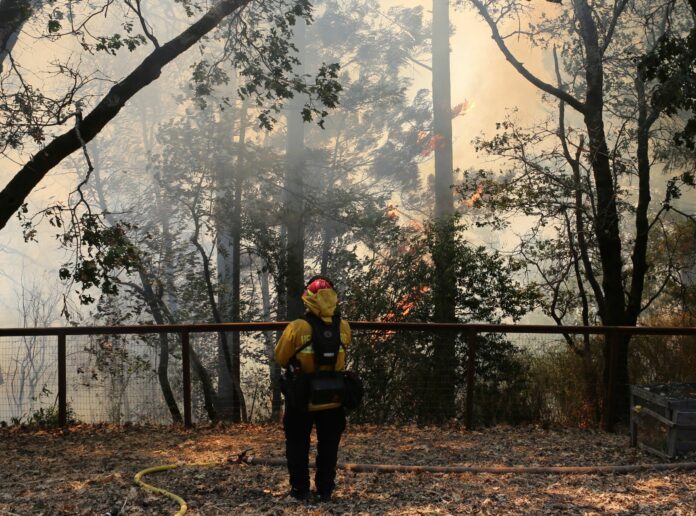Rural service areas covered in proposal
A draft of a proposed budget for North Bay Fire Administration was recently obtained by The Healdsburg Tribune.
The budget is expected to be presented to the Sonoma County Board of Supervisors, possibly as soon as its Jan. 29 meeting.
The budget covers the remainder of the 2018-19 fiscal year, which ends on June 30. The pro-rated time begins in November, which is when contract agreements began. It also presents budget numbers for the full fiscal year including the pro-rated amount in the remainder section. Due to changes in the service area and its management as of late last year, there are no numbers that are comparable from previous budgets readily available.
The pro-rated amount for North Bay Fire expenditures is approximately $2.44 million with revenue for the period November to June totaling over $2.53 million.
Full fiscal year numbers including this amount total nearly $3.28 million in expenditures and over $3.3 million in revenue for North Bay Fire.
The proposed budget for the rest of the fiscal year also includes a proposed budget for County Service Area No. 40 (CSA 40). The proposed budget for this patchwork of service regions is only listed for the November through June period. Expenditures for CSA 40 are a few thousand more than $2.7 million while revenue for the period is more than $2.43 million.
Since North Bay Fire is the administrator for CSA 40, the numbers for each category should not be considered mutually exclusive. In several cases, funds for North Bay Fire are equal to funds for CSA 40.
Money for these budgets is primarily taken in the form of property taxes and is based on the value of the land, including structures and permanent capital on that land.
North Bay Fire and CSA 40 boundaries
North Bay Fire Administration is the body that handles unincorporated areas within the county. It consists of a board of 12 members that represent the dozen former service areas prior to CSA 40’s creation.
Unincorporated is defined in fire service areas as those not under a special taxing district such as incorporated municipalities but also excludes other organized fire districts.
So, in addition to areas such as the city of Healdsburg, which has its own city-funded department, there are fire districts such as Geyserville Fire Protection District, which covers a large swath of land between Healdsburg and Cloverdale. These areas are managed by those district bodies and not directly overseen by North Bay Fire. This does not mean that services are not shared within the county, however.
Areas in CSA 40 include the Geysers area in the northeast part of the county, Bodega, Valley Ford and other spots that do not have existing districts.
How it’s spent
The budget details recommendations for use of budgeted funds.
One of the elements included is the list of key staff positions for the 12 service areas. These include a part-time fire chief and several administrative and management positions. Though the list explains the duties of each position as seen by North Bay Fire, it does not include where any of these positions are to be based out of.
Total expenditures for staff and benefits in the budget are $976,392 for the pro-rated CSA 40 fiscal year. North Bay Fire for the same time is $774,731 with a full fiscal year at more than $1.15 million. The part-time chief position is projected at $145,000 for the full fiscal year.
Services are also broken down in the proposed budget. They include a wide array of items, from contract services to training to printing expenses. The total for CSA 40 November through June is over $1.71 million. The same timeframe for North Bay Fire is $1.65 million, with more than $2.1 million for the fiscal year.
Items of note in the CSA 40 breakdown include $50,500 for volunteer recognition, $58,243 for data services and $712,171 for contract services. Maintenance and fuel for apparatus is budgeted at $161,403.
The proposed budget also includes long-term debt service payments, which is the result of purchasing a type 6 apparatus (modified pickup) for Camp Meeker VFC. Payment November through June for CSA 40/North Bay Fire equals $9,222, with a full fiscal year projection of $18,443. This is expected to pay off the purchase by 2023.
Funding email
In addition to the budget, The Tribune also obtained an email breaking down a draft funding proposal to go before the county board of supervisors. This breakdown of a total just over $6.35 million includes $1.4 million for North Bay Fire to provide services to volunteer fire companies. North Bay Fire is also listed in the email to receive $250,000 for staffing and $400 to provide other districts funding to take over the Camp Meeker, Fort Ross, Knights Valley and Mayacamas areas.
It is possible that the $400 is a typo, as the numbers before it are proceeded with a “k” indicating that the number is in the thousands of dollars range. Thus, the $400 may be $400,000. The email did not contain a total number to check against.
Redistribution issue
One of the issues critics have of budget use is that it unfairly redistributes money in the county and away from high-risk areas. For example, the areas in CSA 40 covering the Geysers includes revenue brought in from the geothermal energy plants, which are some of the highest valued lands in the county. This money, which totaled $770,617 in 2017-18, was collected by the county. The area is primarily serviced by the Geyserville Fire Protection District and Cloverdale Fire District, which are not part of CSA 40. Geyserville Fire said the area received $10,000 to combat fires in this area. Meanwhile, the county has no permanent presence in the area and relies on calls to be handling by neighboring districts.
Redistricting problem
Part of the reason reconsolidation efforts stall is due to the process required by the state to do so. The state uses the Local Agency Formation Commission, which is headed by the county where redistricting is in question. This deliberative process is meant to prevent municipality-led land grabs. It also slows the process of consolidation of fire districts, which has been on ongoing struggle for the county since at least the 1980s.
Some fire district personnel say that redistricting started becoming an issue after the volunteer base that primarily composes most rural area fire staff began to dwindle due to a changing economy. Now, in areas where individuals worked with a larger amount of autonomy, work has become more standardized in that full-time employees cannot sacrifice time on the job to respond to a fire service call.
Even so, the proposed budget addresses “imminent” change in the way the county handles its fire services. The proposal states that administrative duties will have to be refined as these efforts continue and shares writers’ ideas on areas of focus planning. These include, but are not limited to, staffing needs, volunteer recruitment and retention efforts and addressing the Unmet Needs portion of the budget.
The Sonoma County Board of Supervisors will meet next on Jan. 29 at 8:30 a.m. at 575 Administration Drive, Room 102A in Santa Rosa. The agenda will be posted three days prior to the meeting (after press time).









